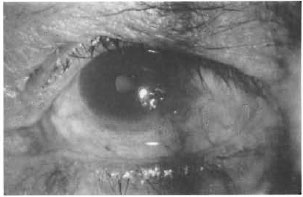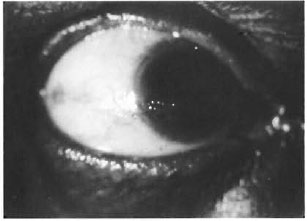- Volume 64 , Number 1
- Page: 66–8
Climatic droplet keratopathy in leprosy
ABSTRACT
An atypical gross form of climatic droplet keratopathy (CDK) occurring in the cornea of 24 eyes of 17 leprosy patients is described. The CDKs were situated in the lower outer quadrant of the cornea and were not associated with trauma, scars or vascularization. All patients, except one, belonged to the lepromatous group. Fifteen of the 24 eyes with this form of CDK had impaired corneal sensation. We suggest that this form of CDK is a distinctive condition found among lepromatous leprosy patients with possible infection and involvement of the corneal nerves.RÉSUMÉ
On décrit une forme atypique et grossière de kératopathie en goutte survenant sur la cornée de 24 yeux provenant de 17 malades de la lèpre. Les keratopathies étaient situées dans le quadrant inféro-externe de la cornée et n'étaient pas associées à un traumatisme, des cicatrices ou une vascularisation. Tous les patients, sauf un, étaient du type lépromateux. Quinze des 24 yeux avec cette forme de kératopathic avaient une sensibilité cornéenne altérée. Nous émettons l'hypothèse que cette forme de kératopathic est une pathologie distincte qui se retrouve parmi les patients lépromateux avec une infection possible et implication des nerfs cornéens.RESUMEN
Se describe una forma de queratopatía climática atípica en la córnea de 24 ojos de 17 pacientes con lepra. Las queartopatías estuvieron localizadas en el cuadrante inferior externo de la córnea y no estuvieron asociados con trauma, cicatrices, o vascularización. Todos los pacientes, excepto uno, fueron del grupo lepromatoso. Quince de los 24 ojos con esta forma de queratopatía tuvieron una disminuida sensibilidad corneal. Sugerimos que esta forma de queratopatía es una condición distintiva encontrada entre los pacientes con lepra lepromatosa con una posible infección y afección de los nervios corneales.The occurrence of degenerative changes in the cornea in leprosy is well known. Bandshaped keratopathy is one such specific degenerative corneal condition that has been associated with leprosy-alfected eyes (9). There have been no reports in the literature of climatic droplet keratopathy (CDK) being associated with leprosy. CDK is the name given to a degenerative condition characterized by the accumulation of translucent material in the superficial corneal stroma within the intcrpalpebral strip, beginning peripherally and spreading centrally (6). A profusion of names based on race, geography, occupation, clinical appearance, and presumed etiology have been used to describe what is likely to be a single pathological response in the cornea (2,4-8). Among the names that have originated to describe this condition, the term CDK has found wide acceptance.
Clinically, two forms of CDK have been described (6). Primary CDK is found bilaterally with translucent or golden-yellow deposits occurring interpalpebrally and without evidence of other corneal pathology. In secondary CDK, the corneal findings reflect those of the responsible pathology, the golden-yellow deposits may surround areas of corneal vascularization, and the condition is usually unilateral. This paper reports the presence of an unusual form of CDK in the cornea of several leprosy patients.
PATIENTS AND METHODS
A disparate form of CDK was noticed in a few patients during routine ocular examination of leprosy patients at the Schieffelin Leprosy Research and Training Center, Karigiri, India. In the cornea of these patients an advanced type of CDK with gross, golden-yellow, globule-like deposits was observed. These globules were easily visible and were confined to a triangular area with a base of about 2-3 mm at the limbus and a height of 3-4 mm, the apex of the triangle extending toward the center of the cornea. This area was situated either at the 4 o'clock position in the left cornea (Fig. 1) or at the 8 o'clock position in the right cornea (Fig. 2). They were not associated with any history of injury, and there were no other opacities or scar tissue present in the cornea of these patients. There was also no associated vascularization of the cornea. In some patients these CDK were unilateral; in others, bilateral. The CDK categorized here did not include those that developed following an obvious injury or on old corneal scars. Those CDK which were observable only on retroillumination with bio-microscopy were also not included in this group.

Fig 1. CDK at 4 o'clock position of left cornea without any underlying scar or vascularization.

Fig. 2. CDK at 8 o'clock position of right cornea without any underlying scar or vascularization.
The general demographic characteristics of these patients and a detailed leprosy history were taken. This included: 1) type of leprosy based on the Ridley and Jopling classification, 2) treatment status, 3) the smear status, 4) antileprosy treatment received, 5) occurrence of type 1 and type 2 reactions, and 6) the presence of a face patch. History of any eye injury was also specifically elicited.
Examination of the anterior segment was done which included 1) visual acuity, 2) presence of lagophthalmos, 3) signs of iridocyclitis (both old and new), 4) corneal sensation, 5) presence of corneal opacity, 6) corneal nerve beading, and 7) presence of cataract. Wherever it was possible, the applanation tension was taken, and in some patients the Schirmer's test was done. A simple diagram depicting the areas in which the CDK was present was drawn.
RESULTS
Twenty-four eyes of 17 leprosy patients exhibited this atypical form of CDK. In 7 patients the condition was bilateral; in 10, unilateral. The age of these patients ranged from 45 years to 73 years with a mean age of 59 years. All patients, except one, were males. All patients had outdoor occupations. Fifteen patients belonged to the polar lepromatous (LL) group, one was borderline lepromatous (13L) and one was diagnosed as secondary neuritic borderline leprosy. The duration of disease of these patients ranged from 5 to 50 years with a mean duration of 29 years. Fourteen of the patients had been released from treatment; three of them were still under antileprosy treatment. In all except one patient skin smears were negative, with all of them showing attributes of resolved cases of leprosy. Two of the LL patients had had type 2 reaction. In 4 eyes there was 3/60 or less visual acuity, in 16 eyes the visual acuity was less than 6/18 but above 3/60, and the remaining 4 eyes had visual acuities of more than 6/12. Two eyes had lagophthalmos. No patient had a face patch. None had signs of acute iridocyclitis. However, one eye showed signs of chronic iridocyclitis. Fifteen out of the 24 eyes had reduced corneal sensation when tested with a wisp of cotton. Nineteen eyes had immature cataract; in two eyes the cataract had been removed. In 16 eyes Schirmer's test was done and three eyes had a Schirmer's test value of 5 mm or less. All 14 eyes in which the intraocular pressure was measured had pressures within normal limits. There was no corneal nerve beading.
DISCUSSION
CDK has been reported by a number of investigators in several countries. Except for trachoma, no other disease has been specifically associated with this condition (10,12). Typically, the primary form of this degenerative condition is described as being situated in the interpalpebral area, starting at the 3 o'clock and 9 o'clock meridians and equally involving the temporal or nasal regions (3,6).
The sites of the CDK in the eyes of these leprosy patients were unusual. They were situated in the 8 o'clock position in the right cornea and in the 4 o'clock position in the left cornea, occupying the lower outer quadrants. The temporal placement of this gross atypical CDK appears to be a distinctive presentation.
The CDK in these patients was not secondary to trauma or scars on the cornea. None of the patients had glaucoma or Fuchs' dystrophy, two other causes known to give rise to the formation of CDK. Correlation of CDK with lagophthalmos would have been illustrative of the etiological factors that have been suggested, such as microtrauma, low temperatures and increased exposure to ultraviolet radiation, but in only two eyes was lagophthalmos a presenting feature.
Demographic characteristics of these patients were similar to those reported by earlier investigators of CDK. There is a preponderance of males of an older age group (1). In this study 21 out of 24 eyes had senile cataract. Further, most of the patients in this group had spent a major portion of their lives outdoors because of their jobs or because of ostracization from the society in which they were living, supporting the theory that ultraviolet radiation plays an important role in the etiology of CDK (11).
Sixteen of the 17 with CDK were BL and LL patients; the one other patient was diagnosed as a secondary neuritic borderline leprosy. Fifteen of the 24 eyes had evidence of corneal nerve involvement with impaired corneal sensation. Therefore, it is reasonable to state that CDK in leprosy is almost always associated with lepromatous leprosy with disseminated disease and the corneal nerves are often infected and their function impaired.
Acknowledgment. The authors acknowledge the help given by Dr. Margaret Brand, Dr. P. S. Sundar Rao and Dr. Charles K. Job in the preparation of this manuscript.
REFERENCES
1. ANDERSON, J. and FUGLSANG, H. Droplet degeneration of the cornea in North Cameroon. Br. J. Ophthalmol. 60(1976)256-262.
2. ETZINE, S. and KAUFMAN, J. C. E. Band-shaped nodular dystrophy of the cornea. Am. J. Ophthalmol. 57(1964)760-763.
3. FRAUNFELDER, F. T. and HANNA, C. Spheroid degeneration of cornea and conjunctiva. I. Clinical course and characteristics. Am. J. Ophthalmol. 74(1972)821-828.
4. FREEDMAN, A. Labrador keratophy. Arch. Ophthalmol. 74(1954) 198-202.
5. GARNER, A., FRAUNFELDER, F. T., BARRAS, T. C. and HINZPETER, E. N. Spheroidal degeneration of the cornea and conjunctiva. Br. J. Ophthalmol. 60(1976)473-378.
6. GRAY, R. H., JOHNSON, G. J. and FREEDMAN, A. Climatic droplet keratopathy. Surv. Ophthalmol. 36(1992)241-253.
7. JOHNSON, G. H. and GHOSH, M. Laborador keratopahy. Can. J. Ophthalmol. 10(1975)119-135.
8. KLINTWORTH, G. K. Chronic actinic keratopathy: a condition associated with conjunctival clastosis (Pingueculae) and typified by characteristic extracellular concretins. Am. J. Pathol. 67(1972)327-348.
9. LAMBA, P. A. and ROHATGI, J. Leprotic keratopathy in India. Indian J. Lepr. 62(1990) 186-192.
10. MATTA, C. S., TABBARA, K. F., CAMERON, J. A., HIDAYAT, A. A. and AL-RAJHI, A. A. Climatic droplet keratopathy with corneal amyloidosis. Ophthalmology 98(1991)192-195.
11. RESNIKOFF, S., FILLIARD, G. and DELL'AQUILA, B. Climatic droplet keratopathy, exfoliation syndrome and cataract. Br. J. Ophthalmol. 75(1991)734-736.
12. TABBARA, K. F. Climatic droplet keratophy. Int. Ophthalmol. Clin. 26(1986)63-68.
1. M.B.B.S., M.S., D.O., Head, Department of Ophthalmology;
2. M.B.B.S., M.D. (Derm.), Head, Branch of Medicine, Schieffelin Leprosy Research and Training Center, Karigiri, North Arcot District, Tamil Nadu 631206, India.
Received for publication on 27 April 1995;
Accepted for publication in revised form on 26 October 1995.